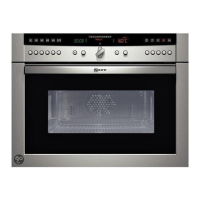10
You can use the
± button to check the current heating
temperature while the oven is heating up. Due to thermal
inertia, the temperature displayed may differ slightly from the
actual temperature in the cooking compartment.
Residual heat indicator
You can see in the temperature display whether there is high or
low residual heat in the cooking compartment.
Setting rapid heating
The rapid heat up function is not suitable for all operating
modes.
Suitable operating modes
■ 3 Hot air
■ 2 Hot air plus and
■ % Top/bottom heat
Suitable temperatures
Rapid heating will not work if the temperature is set to less than
100 °C. If the temperature in the cooking compartment is only
slightly less than the temperature you have set, rapid heating is
not necessary. It will not switch on.
Setting rapid heating
Condition: a suitable operating mode and temperature must
have been set.
1.Set the operating mode and temperature.
2.Repeatedly press the clock function button until the KJuand
f symbols light up and Πappears on the clock display.
3.Turn the rotary selector clockwise.
The clock display shows
Ž and the f symbol lights up.
Rapid heat up is activated.
4.Press theƒ button.
The appliance heats up.
To ensure an even cooking result, do not place your food in the
oven until rapid heat up is complete.
The rapid heat up process is complete
After reaching the set temperature, Rapid heat up switches off.
The
f symbol goes out. Put your food in the oven.
Cancelling rapid heat up
Press the clock function button repeatedly until
Ž appears on
the clock display. Turn the rotary selector anti-clockwise until
Πappears on the clock display. The f symbol on the clock
display goes out.
Notes
■ If you change an operating mode, rapid heat up is cancelled.
■ You can use the ± button to check the current cooking
compartment temperature during rapid heating.
■ Once a cooking time has been set, it will start counting down
immediately after the oven is started, regardless of the rapid
heat up function.
■ If you open the oven door during cooking, rapid heat up-up is
cancelled.
The microwave
Microwaves are converted to heat in foodstuffs. The microwave
can be used solo, i.e. on its own, or in combination with a
different type of heating.
In this section, you will find
■ information about ovenware
■ how to set the microwave
Note: In the Tested for you in our cooking studio section, you
will find examples for defrosting, heating and cooking with the
microwave oven.
Notes regarding ovenware
Suitable ovenware
Suitable dishes are heat-resistant ovenware made of glass,
glass ceramic, porcelain, ceramic or heat-resistant plastic.
These materials allow microwaves to pass through.
You can also use serving dishes. This saves you having to
transfer food from one dish to another. You should only use
ovenware with decorative gold or silver trim if the manufacturer
guarantees that they are suitable for use in microwaves.
Unsuitable ovenware
Metal ovenware is unsuitable. Metal does not allow microwaves
to pass through. Food in covered metal containers will remain
cold.
Caution!
Creation of sparks: metal – e.g. a spoon in a glass – must be
kept at least 2 cm from the oven walls and the inside of the
door. Sparks could destroy the glass on the inside of the door.
Ovenware test
Do not switch on the microwave unless there is food inside. The
following ovenware test is the only exception to this rule.
Perform the following test if you are unsure whether your
ovenware is suitable for use in the microwave:
1.Heat the empty ovenware at maximum power for ½ to
1 minute.
2.Check the temperature occasionally during that time.
The ovenware should still be cold or warm to the touch.
The ovenware is unsuitable if it becomes hot or sparks are
generated.
Microwave power settings
Use the button to set the desired microwave power.
Temperature display Text display
•
Residual heat high
œ
Residual heat low
90 W for defrosting delicate foods
180 W for defrosting and continued cooking
360 W for cooking meat and heating delicate foods
600 W for heating and cooking food
1,000 W for heating liquids

